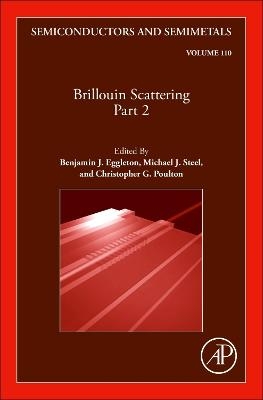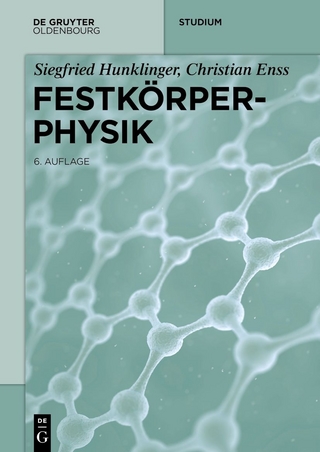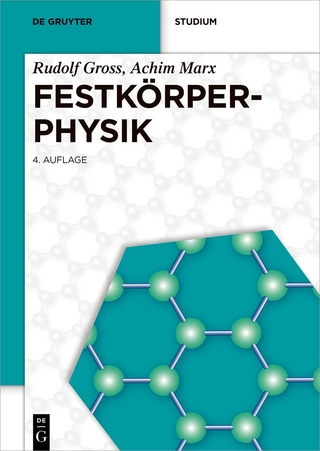
Brillouin Scattering Part 2
Academic Press Inc (Verlag)
978-0-323-98931-2 (ISBN)
Stimulated Brillouin Scattering (SBS) is the strongest third order nonlinearity and plays an important role in contemporary science and applications, particularly lasers, communications, fiber optics and basic physics. This volume provides different perspectives on current technological contexts of SBS in a range of different application areas, including sensing, communications, radar, imaging and information storage.
Professor Benjamin Eggleton is a Professor in the School of Physics at the University of Sydney and the Director of The University of Sydney Nano Institute (Sydney Nano). He also currently serves as co-Director of the NSW Smart Sensing Network (NSSN). Eggleton was the founding Director of the Institute of Photonics and Optical Science (IPOS) at the University of Sydney and served as Director from 2009-2018. He was previously an ARC Laureate Fellow and an ARC Federation Fellow twice and was founding Director of the ARC Centre of Excellence for Ultrahigh bandwidth Devices for Optical Systems (CUDOS) from 2003-2017. Eggleton obtained his Ph.D. degree in Physics from the University of Sydney in 1996. He then joined Bell Laboratories, Lucent Technologies as a Postdoctoral Member of Staff in the Optical Physics Department under the supervision of Dr Richard Slusher. In 1998 Eggleton transferred to the Optical Fiber Research Department as a Member of Technical Staff and was promoted to Technical Manager of the Fiber Gratings Group in 2000. He was then promoted to Research Director within the Specialty Fiber Business Division of Bell Laboratories, where he was engaged in forward-looking research supporting Lucent Technologies business in optical fiber devices. Eggleton is the author or co-author of more than 500 journal publications, including Science, Nature Photonics, Nature Physics, Nature Communications, Physical Review Letters and Optica and over 200 invited presentations. His journal papers have been cited 25,000 times according to webofscience with an h-number of 81 (111 in google scholar). Eggleton is a Fellow of the Australian Academy of Science (AAS), the Australian Academy of Technology and Engineering (ATSE), the Optical Society of America, IEEE Photonics and SPIE. He is Editor-in-Chief of APL Photonics. Eggleton received the 2020 ANZOS W.H. (Beattie) Steel Medal from the Australian Optical Society, the 2020 Eureka Prize for Safeguarding Australia, the 2017 Vice Chancellor Award for Outstanding research, the 2011 Walter Boas Medal (from the Australian Institute of Physics), the 2011 Eureka Prize for Leadership in Science, the 2008 NSW Physicist of the Year medal, the 2007 Pawsey Medal from the Australian Academy of Science, the 2004 Malcolm McIntosh Prize for Physical Scientist of the Year, the 2003 International Commission on Optics (ICO) Prize, the 1998 Adolph Lomb Medal from the Optical Society of America and the IEEE Distinguished Lecturer Award and an R&D100 Award. Michael J. Steel is a Professor of physics in the School of Mathematical and Physical Sciences at Macquarie University in northern Sydney, Australia. His research interests include theoretical nonlinear optics and quantum optics in waveguides, with particular focus on properties of periodic waveguides, generation and manipulation of photon states, opto-acoustic interactions in waveguides, and experimental and theoretical properties of optical devices generated by femtosecond laser direct write processing. Prof. Steel received his PhD in theoretical nonlinear optics in 1996 from the University of Sydney followed by postdoctoral work on Bose-Einstein condensation at the University of Auckland and photonic crystals at Columbia University. In late 2000, he joined the photonic design software company RSoft, where he wrote a number of software tools including advanced physical models for optical communication link-level simulation, and the world’s first commercial photonic band structure analysis tool, BandSOLVE, used in companies and universities throughout the world. In 2007 he joined Macquarie University as an associate professor in optics. From 2016-2021 he was Head of the Department of Physics and Astronomy, also serving as Interim Head of the Department of Mathematics and Statistics during 2019-2020. In 2017-2018, he led a major initiative for Macquarie University to acquire the technology arm of the Australian Astronomical Observatory, and served as Interim Director of the new Australian Astronomical Optics Department of the University from 2018-2019. He has been Secretary of the Australian and New Zealand Optical Society (ANZOS) since January 2021. Christopher G. Poulton is a Professor in the School of Mathematical Sciences at the University of Technology Sydney (UTS). His area of research is theoretical photonics, specializing in numerical and analytical methods in electromagnetic and elastic wave propagation in complex materials. His research includes work on photonic crystal fibres, opto-acoustic scattering, Brillouin scattering, metamaterials, and the modelling of optical nonlinearities. Dr Poulton received his PhD from the University of Sydney in 2000 for his work on electromagnetic and elastodynamic wave propagation in periodic materials. In 2000 he was appointed Lecturer in Applied Mathematics at the University of Liverpool, UK, where he worked on analytic and numerical models of photonic and phononic crystals. From 2002-2005 he was a post-doctoral fellow at the Institute for High-frequency and Quantum Electronics at the University of Karlsruhe (now KIT), Germany, where he worked closely with experimentalists on developing integrated nonlinear devices. At the beginning of 2006 he joined the Max Planck Research Group (photonics and new materials) in Erlangen, Germany, where he worked on plasmonic interactions and guidance in photonic crystal fibres. He returned to Australia to take up a position at UTS in 2007. Prof. Poulton was Head of Discipline of the Mathematical Sciences at UTS from 2015-2022, where he continues to teach, mentor and carry out his research. Since returning to Australia in 2007 much of his research has focused on optomechanics, Brillouin scattering and the mathematics of elastic waves.
Preface Benjamin J. Eggleton, Michael Steel and Chris Poulton 1. SBS-based fiber sensors A. Zadok, X. Bao, Z. Yang and L. Thevenaz 2. Brillouin-based radio frequency sources Moritz Merklein, Thomas Schneider and Kerry John Vahala 3. Stimulated Brillouin scattering for microwave photonics David Marpaung and Yang Liu 4. Integrated Brillouin lasers and their applications Daniel J. Blumenthal, Irina Kabakova, Peter T. Rakich and Kerry Vahala 5. SBS in optical communication systems: The good, the bad and the ugly Bill Corcoran and A. Choudhary 6. Slow light, dynamic gratings and light storage Birgit Stiller, Herbert Winful, Robert Boyd and Moritz Merklein 7. Nonreciprocity in Brillouin scattering Nils T. Otterstrom, Eric A. Kittlaus, Donggyu B. Sohn and Gaurav Bahl 8. Electromechanical Brillouin scattering Huan Li, Omar Florez, Bingcheng Pan, Guilhem Madiot, Clivia M. Sotomayor Torres and Mo Li 9. Brillouin light scattering in biological systems Irina Kabakova, Giuliano Scarcelli and Seok-Hyun Yun
| Erscheinungsdatum | 25.08.2022 |
|---|---|
| Reihe/Serie | Semiconductors and Semimetals |
| Verlagsort | Oxford |
| Sprache | englisch |
| Maße | 152 x 229 mm |
| Gewicht | 730 g |
| Themenwelt | Naturwissenschaften ► Physik / Astronomie ► Festkörperphysik |
| Technik ► Elektrotechnik / Energietechnik | |
| ISBN-10 | 0-323-98931-4 / 0323989314 |
| ISBN-13 | 978-0-323-98931-2 / 9780323989312 |
| Zustand | Neuware |
| Haben Sie eine Frage zum Produkt? |
aus dem Bereich


